The Intel Xeon W-3175X Review: 28 Unlocked Cores, $2999
by Ian Cutress on January 30, 2019 9:00 AM ESTCPU Performance: Web and Legacy Tests
While more the focus of low-end and small form factor systems, web-based benchmarks are notoriously difficult to standardize. Modern web browsers are frequently updated, with no recourse to disable those updates, and as such there is difficulty in keeping a common platform. The fast paced nature of browser development means that version numbers (and performance) can change from week to week. Despite this, web tests are often a good measure of user experience: a lot of what most office work is today revolves around web applications, particularly email and office apps, but also interfaces and development environments. Our web tests include some of the industry standard tests, as well as a few popular but older tests.
We have also included our legacy benchmarks in this section, representing a stack of older code for popular benchmarks.
All of our benchmark results can also be found in our benchmark engine, Bench.
For our graphs, some of them have two values: a regular value in orange, and one in red called 'Intel Spec'. ASUS offers the option to 'open up' the power and current limits of the chip, so the CPU is still running at the same frequency but is not throttled. Despite Intel saying that they recommend 'Intel Spec', the system they sent to us to test was actually set up with the power limits opened up, and the results they provided for us to compare to internally also correlated with that setting. As a result, we're providing both sets results for our CPU tests.
WebXPRT 3: Modern Real-World Web Tasks, including AI
The company behind the XPRT test suites, Principled Technologies, has recently released the latest web-test, and rather than attach a year to the name have just called it ‘3’. This latest test (as we started the suite) has built upon and developed the ethos of previous tests: user interaction, office compute, graph generation, list sorting, HTML5, image manipulation, and even goes as far as some AI testing.
For our benchmark, we run the standard test which goes through the benchmark list seven times and provides a final result. We run this standard test four times, and take an average.
Users can access the WebXPRT test at http://principledtechnologies.com/benchmarkxprt/webxprt/
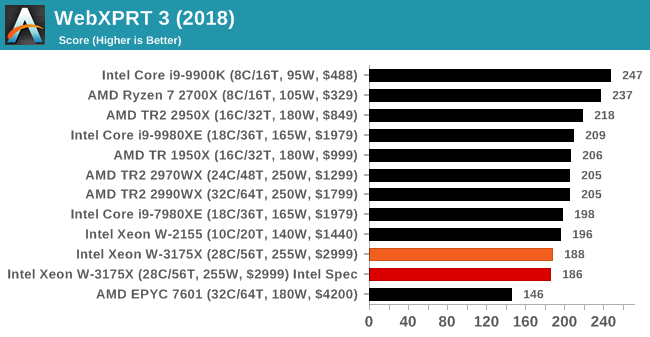
WebXPRT 2015: HTML5 and Javascript Web UX Testing
The older version of WebXPRT is the 2015 edition, which focuses on a slightly different set of web technologies and frameworks that are in use today. This is still a relevant test, especially for users interacting with not-the-latest web applications in the market, of which there are a lot. Web framework development is often very quick but with high turnover, meaning that frameworks are quickly developed, built-upon, used, and then developers move on to the next, and adjusting an application to a new framework is a difficult arduous task, especially with rapid development cycles. This leaves a lot of applications as ‘fixed-in-time’, and relevant to user experience for many years.
Similar to WebXPRT3, the main benchmark is a sectional run repeated seven times, with a final score. We repeat the whole thing four times, and average those final scores.
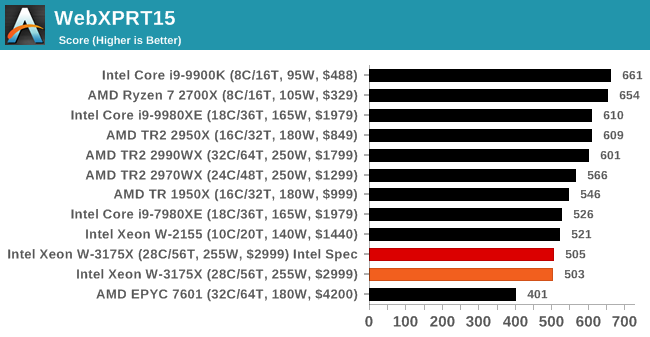
Speedometer 2: JavaScript Frameworks
Our newest web test is Speedometer 2, which is a accrued test over a series of javascript frameworks to do three simple things: built a list, enable each item in the list, and remove the list. All the frameworks implement the same visual cues, but obviously apply them from different coding angles.
Our test goes through the list of frameworks, and produces a final score indicative of ‘rpm’, one of the benchmarks internal metrics. We report this final score.

Google Octane 2.0: Core Web Compute
A popular web test for several years, but now no longer being updated, is Octane, developed by Google. Version 2.0 of the test performs the best part of two-dozen compute related tasks, such as regular expressions, cryptography, ray tracing, emulation, and Navier-Stokes physics calculations.
The test gives each sub-test a score and produces a geometric mean of the set as a final result. We run the full benchmark four times, and average the final results.
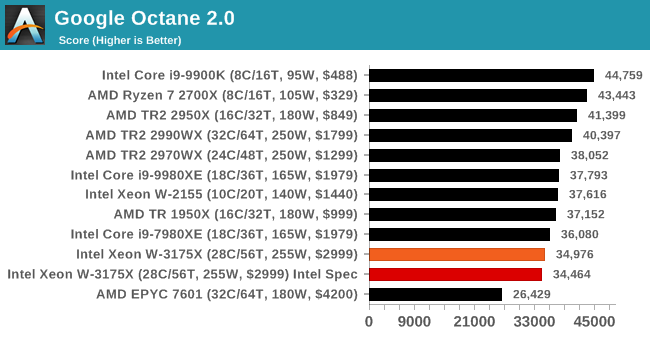
Mozilla Kraken 1.1: Core Web Compute
Even older than Octane is Kraken, this time developed by Mozilla. This is an older test that does similar computational mechanics, such as audio processing or image filtering. Kraken seems to produce a highly variable result depending on the browser version, as it is a test that is keenly optimized for.
The main benchmark runs through each of the sub-tests ten times and produces an average time to completion for each loop, given in milliseconds. We run the full benchmark four times and take an average of the time taken.
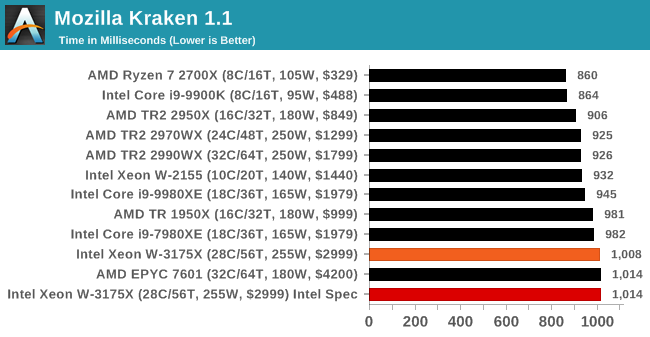
3DPM v1: Naïve Code Variant of 3DPM v2.1
The first legacy test in the suite is the first version of our 3DPM benchmark. This is the ultimate naïve version of the code, as if it was written by scientist with no knowledge of how computer hardware, compilers, or optimization works (which in fact, it was at the start). This represents a large body of scientific simulation out in the wild, where getting the answer is more important than it being fast (getting a result in 4 days is acceptable if it’s correct, rather than sending someone away for a year to learn to code and getting the result in 5 minutes).
In this version, the only real optimization was in the compiler flags (-O2, -fp:fast), compiling it in release mode, and enabling OpenMP in the main compute loops. The loops were not configured for function size, and one of the key slowdowns is false sharing in the cache. It also has long dependency chains based on the random number generation, which leads to relatively poor performance on specific compute microarchitectures.
3DPM v1 can be downloaded with our 3DPM v2 code here: 3DPMv2.1.rar (13.0 MB)

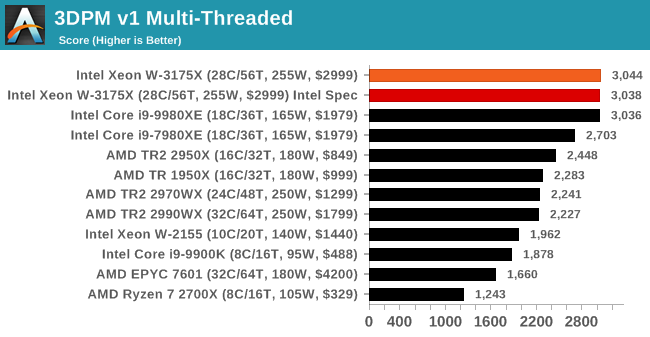
x264 HD 3.0: Older Transcode Test
This transcoding test is super old, and was used by Anand back in the day of Pentium 4 and Athlon II processors. Here a standardized 720p video is transcoded with a two-pass conversion, with the benchmark showing the frames-per-second of each pass. This benchmark is single-threaded, and between some micro-architectures we seem to actually hit an instructions-per-clock wall.

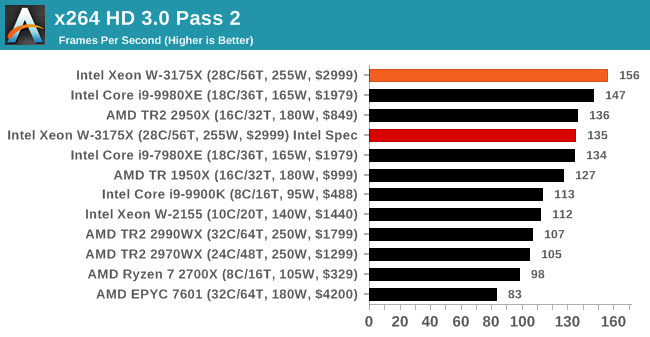










136 Comments
View All Comments
abufrejoval - Wednesday, January 30, 2019 - link
So with the limited edition production numbers, quite clearly the price can be symbolically low, just so Intel can claim bragging rights: They are not interested in satisfying market demands, especially since far too many workstation and server customers might switch over from a Xeon Scalable offering, they just want to claim victory... everywhere... including 10nmJust pathetic!
And honestly, you shouldn't even report about it. Your mission is to inform consumers on products they can buy. If consumers cannot buy it, you should treat it very, very differently, if at all.
You're just being abused by Intel to push a brand that suffers for reasons.
SH3200 - Wednesday, January 30, 2019 - link
This product cannibalizes half the current Xeon lineup as it provides ecc/rdimm at a fraction of the cost. I’d be amazed if FSI customers don’t prebuy every single one ever made before it even hits the public.br83taylor - Wednesday, January 30, 2019 - link
I find it odd Ian is happy to run and report benchmarks with this processor going against Intel recommendation for bios settings, yet would not do it for the AMD processors with their PBO setting. Both of which seem to do very similar things. Letting the 2990WX run with PBO would give it a much fairer chance against this.GreenReaper - Thursday, January 31, 2019 - link
It's not unressonablr to test the system as given to you, especially when it is provided as a complete system, so may represent what end-users get. That said, it seems like he kinda called that out in the sideways manner by highlighting the fact that the system Intel had shipped to him was not actually using those specifications.outsideloop - Wednesday, January 30, 2019 - link
This reminds me of the FX-9590. Massively overclocking silicon to keep up. Except now, the shoe is on the other foot.wow&wow - Wednesday, January 30, 2019 - link
Xeon W-3175X: $2999+$1500= $4499Ryzen TR 2900WX: $1799+$300= $2099
Is Intel trying to market it for “stupids” or those whose left brains being not right and right brains having nothing left :-D
ksec - Wednesday, January 30, 2019 - link
I think we need some new innovation in Thermal Cooling, how we could cool more with less, ease and cheaper. We pushed to near 600W for CPU and GPU alone.mapesdhs - Saturday, February 2, 2019 - link
Ye cannae beat the laws of physics. :D Thermal density is a hard problem. Check out AdoredTV's video on the subject, it explains things nicely.The_Assimilator - Wednesday, January 30, 2019 - link
This is Pentium 4 days all over again.bananaforscale - Thursday, January 31, 2019 - link
Kitty approves of heat output.